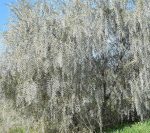 Also known as 4-stamen tamarix and salt cedar, this evergreen tree is native to coastal areas of the eastern Mediterrean, Iran and the Arabian Peninsula where it grows in sandy soils, swamps, and the edges of salt marshes. It is a member of the Tamaricaceae, a small family of less than 60 species. Plants grow 3-10′ tall and have smooth reddish brown bark and very small scale-like gray-green leaves. The white, 4-5 petaled flowers appear in racemes 1-3.5″ long from spring into summer and give way to tiny pyramidal seed capsules. Photo Credit: Ruben Mor Wikimedia
Also known as 4-stamen tamarix and salt cedar, this evergreen tree is native to coastal areas of the eastern Mediterrean, Iran and the Arabian Peninsula where it grows in sandy soils, swamps, and the edges of salt marshes. It is a member of the Tamaricaceae, a small family of less than 60 species. Plants grow 3-10′ tall and have smooth reddish brown bark and very small scale-like gray-green leaves. The white, 4-5 petaled flowers appear in racemes 1-3.5″ long from spring into summer and give way to tiny pyramidal seed capsules. Photo Credit: Ruben Mor Wikimedia
The Hebrew word seechim is usually translated as bush or shrub and is thought to refer to one of three species of Tamarix tree: T. articulata, T. pentandra, and/or T. tetragyna. In addition, the Hebrew word eshel, usually translated as grove, tree, shrub, wood, or tamarix, could also be one of these three species of Tamarix.
Genesis 21: 15 (NIV) As Hagar and Ishmael traveled away from Abraham their supplies ran out and they expected to die.
“When the water in the skin was gone, she put the boy under one of the bushes.”
Genesis 21:33 (NIV) After making a treaty with Abimelech….
“Abraham planted a tamarisk tree in Beersheba, and there he called on the name of the LORD, the Eternal God.”
I Samuel 22:6 (NIV) Four hundred discontented men came to David.
“Now Saul heard that David and his men had been discovered. And Saul was seated, spear in hand, under the tamarisk tree on the hill at Gibeah, with all his officials standing at his side.”
I Samuel 31:13 (NIV) After the Philistines killed Saul and his sons, the men of Jabesh Gilead took their bodies and prepared them for burial.
“Then they took their bones and buried them under a tamarisk tree at Jabesh, and they fasted seven days.”
Desert tamarix likes full sun, and sandy, salty, wet to medium moist soil. It is generally healthy and requires little care. Propagation is by seed or cuttings.
The genus name, Tamarix, is derived from the Tamaris River in Spain. The specific epithet, tetragyna, comes from the Greek words tetra meaning four, and gyne,meaning female, and refers to 4 stigmas or carpels, the female parts of the flowers.